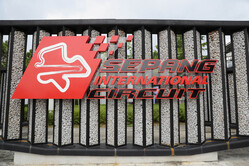


02/10/2017
NEWS STORY
 Mat Coch writes
Mat Coch writes
Formula 1 in Malaysia is now consigned to history; it has gone the way of the way of the dodo. It has ceased to be, gone it meet its maker. In short, it is an ex-Grand Prix.
Formula 1 first visited Sepang in 1999. It held 19 races before bowing out with a Max Verstappen race win. In that period we have seen drama and controversy, notably the Multi 21 episode of 2013, and frequent bouts of Monsoonal rain playing havoc with proceedings.
The reality is however that the financial and commercial side of the sport has accelerated to the point where Sepang, a circuit built for the express purpose of hosting Formula 1, can no longer justify it.
On Sunday afternoon, little more than an hour before the race start, Chase Carey, the Malaysian Prime Minister and a host of other dignitaries faced the media. It made for fascinating viewing as they attempted to present a harmonious group of people, where in reality there were two very different camps.
On one side were those in charge of the Malaysian race; the Prime Minister and the Sepang circuit officials. They've publicly questioned the value of the race for over a year, as Pitpass' esteemed editor pointed out yesterday, and reached the conclusion that the return doesn't justify the investment.
On the other side of the equation was Chase Carey, the boss of Formula 1 who was unshakeable in his stance that he has plenty of other countries lining up for a race – more than he can in fact accommodate. His message, if one filters out the public relations waffle, was something along the lines of ‘we don't care if you don't want the race, we've already got your money'.
Sure, that's an over simplification of the situation, but one can't blame the promoters for their decision. Malaysia has a significant amount of Formula 1 advertising, courtesy of oil company Petronas' involvement with Mercedes, but also from promoters trying to lure locals to the race itself.
The problem is, the locals just aren't interested. MotoGP sells out and yet the grandstand opposite the pit building had swathes of empty seats come Sunday's grand prix. It had filled up from Saturday, where it was only about half full, but even with ticket prices heavily discounted the event was far from a sell-out.
Not helping the event was the lack of support categories. There was a Porsche Carrera Cup Asia round, which featured a handful of known names such as Will Bamber (brother of Earl), a local improved production style class and Formula 4 South East Asia. The Formula 4 event was notable for ending Race 3 with no finishers after the entire field ran out of fuel.
Perhaps with a different supporting cast the event would be more popular, but attracting fans to the race track is a universally constant challenge.
Each December the venue hosts a 12 Hour GT race which attracts a world class field, but it never attracts fans in big numbers. There are rumours that Australian touring cars, Supercars, could visit the circuit from 2019 but even that is a gamble despite it being more closely aligned with the modified car culture, which is prevalent in Malaysia.
And that is the quandary. Spend any time on the road in Malaysia and you will quickly discover the car culture is very healthy – too healthy one might suggest as you suppress a snigger with the sorts of modifications youngsters perform to cars better left on the scrap heap.
The Sepang circuit is funded by the Malaysian government. Each year it submits a list of events it believes will contribute positively to the local economy. This is in terms of part-time employment, tourism, and all the other benefits associated with hosting a large scale event of any type.
The Malaysian government will then give events the red of green light and, in this instance, has elected not to approve continued investment in Formula 1.
And who can blame them? Malaysia is now better known than it ever has been and Formula 1 certainly played a part in that, but Kuala Lumpur is a world-renowned city and the value it receives from Formula 1 no longer justifies the continued investment.
We therefore bid farewell to Malaysia, probably forever, but with just one last note.
If this is the conclusion reached in Sepang, the first of that new generation, what does it say for the mindset of China, Singapore, Bahrain, Russia, Abu Dhabi and Azerbaijan, events which all joined the calendar with similar motives to Malaysia's?
It's a good thing Mr Carey could fill a page with places wanting to host a race.